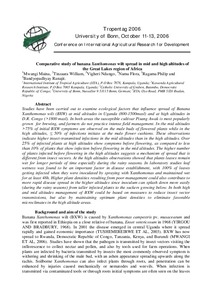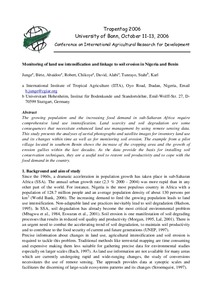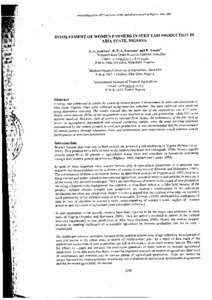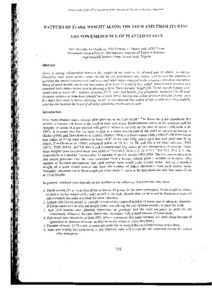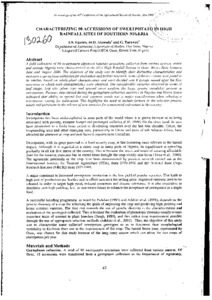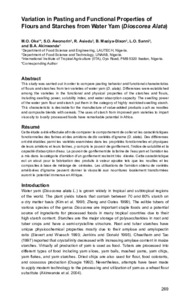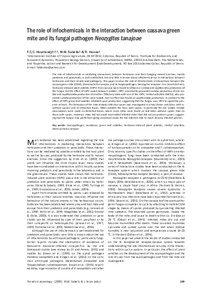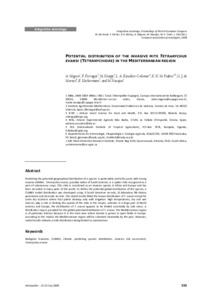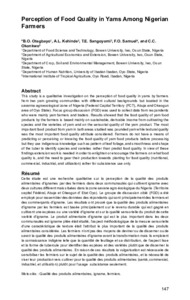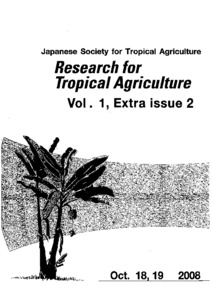Welcome to the International Institute of Tropical Agriculture Research Repository
Conference Documents: Recent submissions
Now showing items 481-500 of 597
-
Adoption of improved cassava varieties in Uganda: implications for agricultural research and technology dissemination
(2007)Improved germplasm from the cassava-breeding program has generated new varieties that are increasingly being grown by farmers in Uganda.In this study, the socio-economic and demographic characteristics of cassava farmers in different regions of Uganda, adopted cassava varieties, their adoption rates, desirable and undesirable attributes, and factors that have influenced the speed of adoption of the most adopted variety were determined. ... -
Comparative study of banana Xanthomonas wilt spread in mid and high altitudes of the Great Lakes region of Africa
(2006)Studies have been carried out to examine ecological factors that influence spread of Banana Xanthomonas wilt (BXW) at mid altitudes in Uganda (800-1500masl) and at high altitudes in D.R. Congo (>1800 masl). In both areas the susceptible cultivar Pisang Awak is most popularly grown for brewing, and farmers do not practice intense field management. In the mid altitudes >75% of initial BXW symptoms are observed on the male buds of flowered plants while in the high altitudes, ≤50% of infections initiate ... -
Monitoring of land use intensification and linkage to soil erosion in Nigeria and Benin
(2006)The growing population and the increasing food demand in sub-Saharan Africa require comprehensive land use intensification. Land scarcity and soil degradation are some consequences that necessitate enhanced land use management by using remote sensing data. This study presents the analyses of aerial photographs and satellite images for inventory land use and its changes within time as well as for monitoring soil erosion. The example from a pilot village located in southern Benin shows the increase ... -
Involvement of women farmers in seed yam production in Abia state, Nigeria
(2006)A survey was conducted to assess the extent of women farmer's involvement in seed yam production in Abia State, Nigeria. Data were collected using intensive, schedule. The data collected were analysed using descriptive statistic. The results show that the mean age of the respondents was 47.7 years. Ninety seven percent 97% of the respondents were involved in seed yam production. While 93% were actively involved. However, lack of access to relevant farm inputs, the tediousness of the job, lack of ... -
Pattern of stake weight along the stem axis from its base and non emergence of planted stakes
(2006)There is strong relationship between the weight of stake to be planted and it ability to emerge. Therefore, only good quality stem should be cut, partitioned into stakes, and treated for planting to optimise the limited resource of land area and other input engaged in the cassava cultivation enterprise. Stems of good health can cut into stake of at least 50gm, and if they satisfy severe other features of a standard stake before being used in planting a field. These includes: length (20-25cm), age ... -
Standard stake yield of 43 CMD cassava genotypes in 11 locations of Nigeria: implications for stem supply systems
(2006)Standard stake yield (SSY) was estimated using data from multi-locational trials in 11 locations. These were: Onne, Obrikom, Warri, Obayantor, Umudike, Nanka, Akure, Ajibode, Ibadan, and Zaria during 2003-2005 season. The aim was to identify location suitable for stem production and also to estimate the quantity of standard stakes obtainable per plant for all the 43 IITA- CMA resistant genotypes. Stakes of 25cm long cut from matured healthy plant were planted at 1mx1m on flat or ridges. No fertilizer ... -
Determination of micronutrients and colour variability among new plantain and banana hybrids flour
(2006)Quantitative colour variability and micronutrient content of new plantain and banana hybrids flour was investigated. The mean flour colour of the cultivars ranges from 12.16 for BITA 3 to 18.52 for FHIA 23, which is an indication of varying degree of yellowness. Both FHIA 23 and PITA 17 had colour value higher than the general sample means. Agbagba contained the highest level of iron (36.5 µg g ), which is higher than 1the overall sample means, followed by FHIA 17 (16.135 µg g ). The rest of the ... -
Evaluation of 5 hybrid yams for dry season yam production in lowland areas
(2006)A two year trial was conducted at the inland valley of the National Root Crop Research Institute, Umudike during the dry season of 2003/2004 and 2004/2005. The purpose was to evaluate the suitability of five hybrid yam clones of dry season yam production. The yams were planted in manually made ridges and laid out in RCB design in three replicates. Fresh yam tuber yield 22.6t/ha; 21.8t/ha: 19.1 t/ha and 18.1 t/ha were respectively achieved from TDr 95/18949: Tdr 97/00925; TDr 03/00193 and TDR ... -
Characterizing 90 accessions of sweetpotato in high rainfall sites of southern Nigeria
(2006)A field collection of 90 sweetpotato (lpomoea batatas) accession collected. from various sources within and outside Nigeria were characterized at the llTA High Rainfall Station in Onne, Rivers State between June and August 2006. The objective of the study was to identify their distinctive characteristics and mountain of germplasm collection for evaluation and further research. Some of the accessions were found to be similar, based on whole-plant characteristics and were divided into 8 groups named ... -
Variation in pasting and functional properties of flours and starches from water yam (Dioscorea alata)
(2009)This study was carried out in order to compare pasting behavior and functional characteristics of flours and starches from ten varieties of water yam (D. alata). Differences were established among the arieties in the functional and physical properties of the starches and flours, including swelling power, solubility index, and water absorption capacity. The swelling power of the water yam flour and starch put them in the category of highly restricted swelling starch. This characteristic ... -
Screening and breeding for resistance to maize stem borers and Eldana in West and Central Africa
(2009)Stem borers are one of the major constraints limiting maize productivity in Africa. The most important species reducing maize yield in West and Central Africa are Sesamia calamistis, Eldana saccharina and Busseola fusca. Both the pink stem borer (Sesamia calamistis Walker (Pyralidae) and the sugarcane borer Eldana saccharina Hampson (Noctuidae) infest and reduce maize yields in the lowlands of West and Central Africa. Host pant resistance is very effective in managing the pests and researches ... -
Role of infochemicals in the interaction between cassava green mites and its fungal pathogen Neozygites tanajoae
(2009)The role of infochemicals in mediating interactions between herbivores and their foraging natural enemies, mainly predators and parasitoids, is well established, but very little is known about infochemical use in interactions between herbivores and their sit-and-wait pathogens. This paper reviews the role of infochemicals in interactions between the cassava green mite (CGM), Mononychellus tanajoa,and its fungal pathogen, Neozygites tanajoae. In a closed-dish test, herbivore-induced plant volatiles ... -
Potential distribution of the invasive mite Tetranychus evansi (Tetranychidae) in the Mediterraean region
(2008)Predicting the potential geographical distribution of a species is particularly useful for pests with strong invasive abilities. Tetranychus evansi, possibly native of South America, is a spider mite recognized as a pest of solanaceous crops. This mite is considered as an invasive species in Africa and Europe and has been recorded in many parts of the world. To define the potential global distribution of the species, a CLIMEX model distribution was developed using: i) South American records, ii) ... -
Perception of food quality in yams among Nigerian farmers
(2009)This study is a qualitative investigation on the perception of food quality in yams by farmers from two yam growing communities with different cultural backgrounds but located in the savanna agroecological zone of Nigeria (Federal Capital Territory (FCT), Abuja and Okeogun area of Oyo State). Focus group discussion (FGD) was used to collect data from respondents who were mainly yam farmers and traders. Results showed that the food quality of yam food products by the farmers is based ... -
Optimum time for collecting root samples for chromosome observation in Dioscorea spp.
(2010)The genus Dioscorea is considered to be one of the most difficult groups for cyto-taxonomic studies because of the large number and small size of the chromosomes. The objective of the present study was to develop an efficient method of chromosome. Observation by identifying the optimum time for collecting root samples containing large number so for metaphase cells. In the present investigation, two breeders’ lines developed at IITA, TDa98/01183(D. alata) and TDr95/18544(D. rotundata) which were ... -
Grain yields of rust resistant promiscuous soybean lines in the Guinea savanna of Nigeria
(2009)Soybean rust, caused by Phakopsora pachyrhizi, has become a threat to soybean production in west, central, east and southern Africa. This foliar disease can cause 40-80% yield loss under African conditions. IITA started to develop resistant lines for this disease since 2003 and a number of homozygous lines from the breeding program have reached line evaluation stage. Seventeen F8 rust resistant lines derived from the cross TGx 1805-31F (rust susceptible elite line) with UG 5 (rust resistant line), ...


